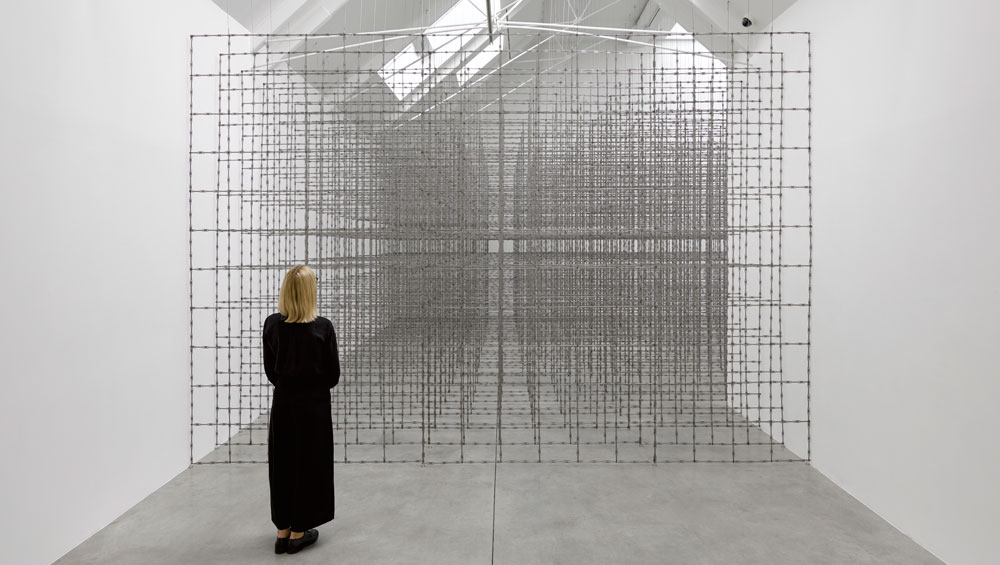
Lisson Gallery, London
14 July – 26 August 2017
by ALEXANDER GLOVER
“I don’t try to produce beautiful artefacts to satisfy our senses and console us from harsh reality, but to bring that reality to the forefront of artistic representation and confront us with it,” said Spanish artist Santiago Sierra, who was born in Madrid in 1966. But perhaps for the first time since the 1990s, it appears that beauty has accidentally infiltrated Sierra’s work in his new show at the Lisson Gallery’s Bell Street location.
The new work, Impenetrable Structure (2017), is an enormous grid-like cage built with the same kind of military razor wire used in war zones and to create security perimeters that restrict movement between countries. Think Mona Hatoum’s Light Sentence (1992), in which wire mesh lockers are placed in the centre of the room and appear to fill the whole space through light and shadow, orchestrated by a slow-moving motorised light bulb nestled in between the lockers. But where there is light in Hatoum’s piece, projecting small beams of hope and possibility, Sierra’s latest installation does the opposite, with its stark presentation of a brutal reality. Having said that, the sheer scale of the piece combined with the almost perfect alignment of the razor wires creates an uncomfortable aesthetic that is as beautiful as it is intimidating.
.-Installation-view,-Lisson-Gallery-London,-July-2017..jpg)
Santiago Sierra. Impenetrable Structure, 2017. Installation view, Lisson Gallery London, July 2017. Photograph: Jack Hems. © Santiago Sierra; Courtesy Lisson Gallery.
Impenetrable Structure consumes the entirety of the main gallery space and can be viewed by only one person at a time, in a small, designated area guarded attentively – over your shoulder, in fact – by an invigilator. Sierra’s intention with this is to create a sense of frustration for the viewer through the rejection of physical access. It is an environment that strongly alludes to the restrictive measures put in place with regard to immigration and protest that have become increasingly present in the global context.
-Santiago-Sierra-.jpg)
Santiago Sierra. Space closed off by corrugated metal (Lisson Gallery, London, UK, 2002). © Santiago Sierra; Courtesy Lisson Gallery
For Sierra’s first exhibition at the same location 15 years ago, he experimented with these concepts with his piece Space closed by corrugated metal, Lisson Gallery, London, September 2002 (2002). This subversive piece saw Sierra completely shut off the entrance to the newly opened Bell Street location for three weeks. In the aftermath of the opening night, there were reports of art collectors vowing never to purchase artworks from the gallery again. This critique of institutional structures through a minimal visual gesture was later echoed by Berlin-based artist Maria Eichhorn and her work 5 weeks, 25 days, 175 hours (2016) at Chisenhale Gallery, London, last year. Questions similar to Sierra’s, concerning contemporary labour conditions, were put forward by Eichhorn by closing the gallery and then relieving the gallery’s staff of their duties for the five weeks of her exhibition, using her commission to pay for the running costs during this period.
Sierra’s first show at Lisson Gallery in 2002 was just one example of the kind of controversy that follows the artist. At the Venice Biennale the following year, he erected a cement wall around the Spanish Pavilion to prevent all visitors, except Spaniards, from entering. This presentation drew on similar themes explored in Impenetrable Structure, such as estrangement and division. As well as using military materials throughout his career to highlight these themes, there is another side to Sierra’s daring practice: addressing the exploitative framework of capitalism. When addressing this topic, Sierra often pays people to be involved whose situation and place in society emphasise the extreme inequalities present in a capitalist society. A key example of this is his work 160cm Line Tattooed on 4 people (2000), a video showing four female prostitutes addicted to heroin who were hired for the price of a shot of heroin and gave their consent to having a line tattooed on their backs. The performance was filmed at El Gallo Arte Contemporáneo in Salamanca, Spain, and shows the four women with their backs to the camera while the action was taking place. Because the performance was made in an arts institution, and subsequently shown in galleries and museums, Sierra forces the institution to engage with ethical questions surrounding the hierarchical structures enforced by a capitalist society. What is even more morally equivocal is the fact that this piece, and many of Sierra’s other works concerning the imbalance of power and money, are then purchased by those in the art world as commodities.
Sierra’s uncompromising approach to his practice will always attract news headlines around the world. In May this year, he organised a new performance piece across several continents, for eight days, called The names of those killed in the Syrian conflict, between 15th of march 2011 and 31st of December 2016 (2017). The performance features pairs of Arabic speakers reading out, as the title suggests, the names of 144,308 people killed during the conflict. The performance followed an east to west route that started at the Centre for Contemporary Art in Tel Aviv, Israel, moving to Wiener Festwochen in Vienna, Austria, and the Lisson Gallery, London, before finishing in Buenos Aires at the Performance Biennale BP.17. This performance, combined with Impenetrable Structure, demonstrates Sierra’s unique ability to translate concerns that have been worked on and voiced for years into relevant and timely contexts. At a time when global political agendas are becoming more aggressively isolationist and violent, the need for an equally brutal artistic assessment of these situations seems all the more urgent.